NVIDIA’s GeForce GTX 480 and GTX 470: 6 Months Late, Was It Worth the Wait?
by Ryan Smith on March 26, 2010 7:00 PM EST- Posted in
- GPUs
Temperature, Power, & Noise: Hot and Loud, but Not in the Good Way
For all of the gaming and compute performance data we have seen so far, we’ve only seen half of the story. With a 500mm2+ die and a TDP over 200W, there’s a second story to be told about the power, temperature, and noise characteristics of the GTX 400 series.

Starting with idle temperatures, we can quickly see some distinct events among our cards. The top of the chart is occupied solely by AMD’s Radeon 5000 series, whose small die and low idle power usage let these cards idle at very cool temperatures. It’s not until half-way down the chart that we find our first GTX 400 card, with the 470 at 46C. Truth be told we were expecting something a bit better out of it given that its 33W idle is only a few watts over the 5870 and has a fairly large cooler to work with. Farther down the chart is the GTX 480, which is in the over-50 club at 51C idle. This is where NVIDIA has to pay the piper on their die size – even the amazingly low idle clockspeed of 50MHz/core 101MHz/shader 67.5Mhz/RAM isn't enough to drop it any further.

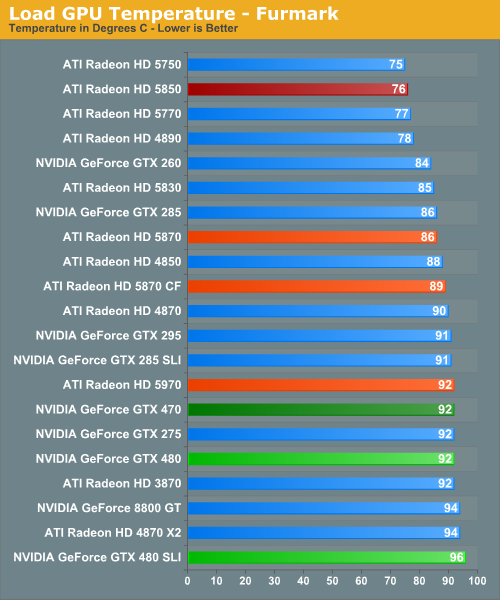
For our load temperatures, we have gone ahead and added Crysis to our temperature testing so that we can see both the worst-case temperatures of FurMark and a more normal gameplay temperature.
At this point the GTX 400 series is in a pretty exclusive club of hot cards – under Crysis the only other single-GPU card above 90C is the 3870, and the GTX 480 SLI is the hottest of any configuration we have tested. Even the dual-GPU cards don’t get quite this hot. In fact it’s quite interesting that unlike FurMark there’s quite a larger spread among card temperatures here, which only makes the GTX 400 series stand out more.
While we’re on the subject of temperatures, we should note that NVIDIA has changed the fan ramp-up behavior from the GTX 200 series. Rather than reacting immediately, the GTX 400 series fans have a ramp-up delay of a few seconds when responding to high temperatures, meaning you’ll actually see those cards get hotter than our sustained temperatures. This won’t have any significant impact on the card, but if you’re like us your eyes will pop out of your head at least once when you see a GTX 480 hitting 98C on FurMark.
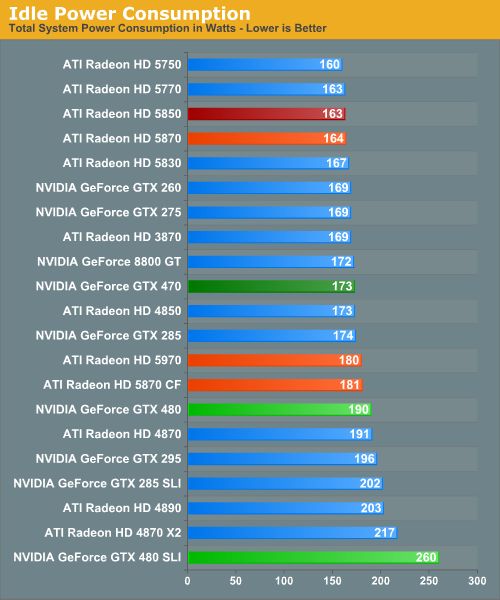
Up next is power consumption. As we’ve already discussed, the GTX 480 and GTX 470 have an idle power consumption of 47W and 33W respectively, putting them out of the running for the least power hungry of the high-end cards. Furthermore the 1200W PSU we switched to for this review has driven up our idle power load a bit, which serves to suppress some of the differences in idle power draw between cards.
With that said the GTX 200 series either does decently or poorly, depending on your point of view. The GTX 480 is below our poorly-idling Radeon 4000 series cards, but well above the 5000 series. Meanwhile the GTX 470 is in the middle of the pack, sharing space with most of the GTX 200 series. The lone outlier here is the GTX 480 SLI. AMD’s power saving mode for Crossfire cards means that the GTX 480 SLI is all alone at a total power draw of 260W when idle.
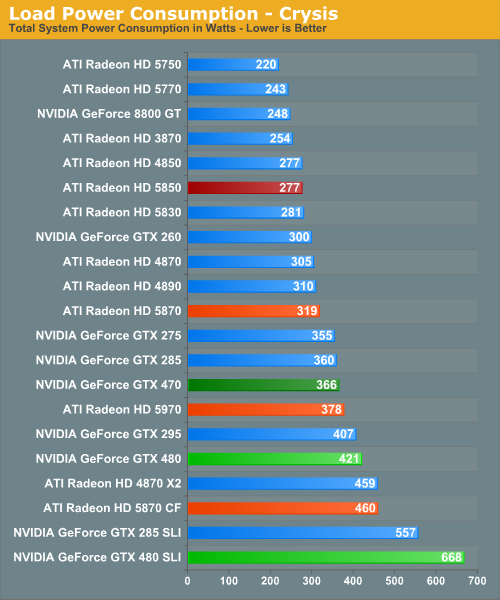
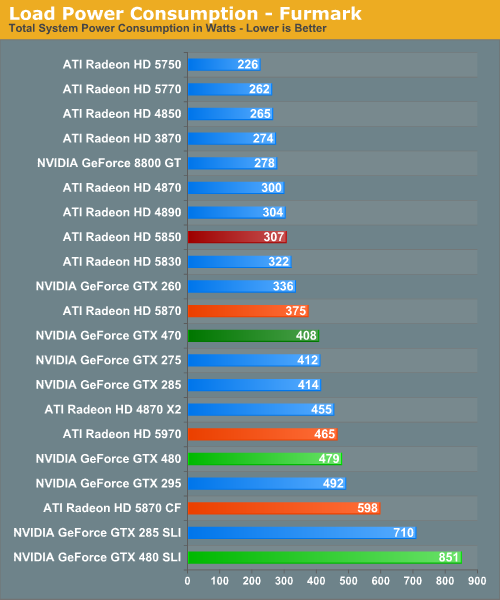
For load power we have Crysis and FurMark, the results of which are quite interesting. Under Crysis not only is the GTX 480 SLI the most demanding card setup as we would expect, but the GTX 480 itself isn’t too far behind. As a single-GPU card it pulls in more power than either the GTX 295 or the Radeon 5970, both of which are dual-GPU cards. Farther up the chart is the GTX 470, which is the 2nd most power draining of our single-GPU cards.
Under FurMark our results change ever so slightly. The GTX 480 manages to get under the GTX 295, while the GTX 470 falls in the middle of the GTX 200 series pack. A special mention goes out to the GTX 480 SLI here, which at 851W under load is the greatest power draw we have ever seen for a pair of GPUs.

Idle noise doesn’t contain any particular surprises since virtually every card can reduce its fan speed to near-silent levels and still stay cool enough. The GTX 400 series is within a few dB of our noise floor here.
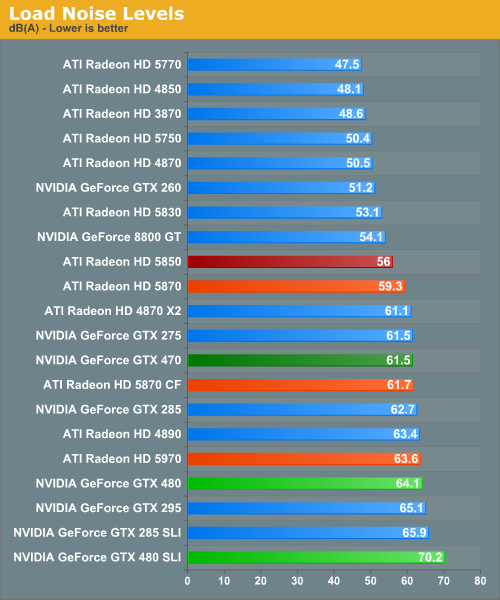
Hot, power hungry things are often loud things, and there are no disappointments here. At 70dB the GTX 480 SLI is the loudest card configuration we have ever tested, while at 64.1dB the GTX 480 is the loudest single-GPU card, beating out even our unreasonably loud 4890. Meanwhile the GTX 470 is in the middle of the pack at 61.5dB, coming in amidst some of our louder single-GPU cards and our dual-GPU cards.
Finally, with this data in hand we went to NVIDIA to ask about the longevity of their cards at these temperatures, as seeing the GTX 480 hitting 94C sustained in a game left us worried. In response NVIDIA told us that they have done significant testing of the cards at high temperatures to validate their longevity, and their models predict a lifetime of years even at temperatures approaching 105C (the throttle point for GF100). Furthermore as they note they have shipped other cards that run roughly this hot such as the GTX 295, and those cards have held up just fine.
At this point we don’t have any reason to doubt NVIDIA’s word on this matter, but with that said this wouldn’t discourage us from taking the appropriate precautions. Heat does impact longevity to some degree – we would strongly consider getting a lifetime warranty for the GTX 480 to hedge our bets.










196 Comments
View All Comments
ReaM - Saturday, March 27, 2010 - link
I don't agree with final words.480 is crap. Already being expensive it adds huge power consumption factor only to have a slightly better performance.
However (!), I see a potential for future chips and I can't wait for a firmy Quadro to hit the market :)
Patrick Wolf - Saturday, March 27, 2010 - link
6 months and we get a couple of harvested, power-sucking heaters? Performance king, barely, but for what cost. Cards not even available yet. This is a fail.This puts ATI in a very good place to release a refresh or revisions and snatch away the performance crown.
dingetje - Saturday, March 27, 2010 - link
exactly my thoughtsand imo the reviewers are going way to easy on nvidia over this fail product (except maybe hardocp)
cjb110 - Saturday, March 27, 2010 - link
You mention that both of these are cut-down GF100's, but you've not done any extrapolation of what the performance of a full GF100 card would be?We do expect a full GF100 gaming orientated card, and probly before the end of the year, don't we?
Is that going to be 1-9% quicker or 10%+?
Ryan Smith - Saturday, March 27, 2010 - link
It's hard to say since we can't control every variable independent of each other. A full GF100 will have more shading, texturing, and geo power than the GTX 480, but it won't have any more ROP/L2/Memory.This is going to heavily depend on what the biggest bottleneck is, possibly on a per-game basis.
SlyNine - Saturday, March 27, 2010 - link
Yea and I had to return 2 8800GT's from being burnt up. I will not buy a really hot running card again.poohbear - Saturday, March 27, 2010 - link
Oh how the mighty have fallen.:( i remember the days of the 8800gt when nvidia did a hard launch, released a cheap & excellent performing card for the masses. W/ the fermi release u would never know its the same company. Such a disappointment.descendency - Saturday, March 27, 2010 - link
I think the MSRP is lower than $300 for the 5850 (259) and lower than $400 for the 5870 (379). Just thought that was worth sharing.I have to believe that the demand will shift back evenly now and price drops for the AMD cards can ensue (if nothing else, the cards should go to the MSRP values because competition is finally out). I would imagine the price gap between the GTX480 and the AMD 5870 could be as much as $150 dollars when all is said and done. Maybe $200 dollars initially as this kind of release almost always is followed by a paper launch (major delays and problems before launch = supply issues).
AnnonymousCoward - Saturday, March 27, 2010 - link
...for two reasons: power and die size.So the 5870 and 470 appear to be priced similarly, while the 5870 beats it in virtually every game and uses 47W less at load! That is a TON of additional on-die power (like 30-40A?).
We saw this coming last year when Fermi was announced. Now AMD is better positioned than ever.
IVIauricius - Saturday, March 27, 2010 - link
I see why XFX started making ATI cards a few years ago with the 4000 series. Once again nVidia has made a giant chip that requires a high price tag to offset the price of manufacturing and material. The same thing happened a few years ago with the nVidia GTX200 cards and the ATI 4000 cards. XFX realized that they weren't making as much money as they'd like with GTX200 cards and started producing more profitable ATI 4000 cards.I bought a 5870 a couple months ago for $379 at newegg with a promotion code. I plan on selling it not to upgrade, but to downgrade. A $400 card doesn't appeal to me anymore when, like many posters have mentioned, most games don't take advantage of the amazing performance these cards offer us. I only play games like MW2, Borderlands, Dirt 2, and Bioshock 2 at 1920x1080 so a 4870 should suffice my needs for another year. Maybe then I'll buy a 5850 for ~$180.
First post, hope I didn't sound too much like a newbie.
-Mauro